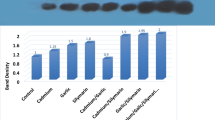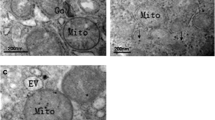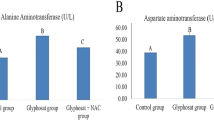Abstract
Plasma glutathione is markedly decreased in human cirrhosis of the liver. This decrease is said to be caused by reduced concentrations of liver glutathione. However, several studies on hepatic glutathione have revealed its concentrations to be unchanged, decreased, or even elevated. To test these inconsistencies we investigated the glutathione status of plasma, liver, and kidney in rats chronically exposed to carbon tetrachloride (CCl4). After 14 weeks of CCl4 treatment, histological examination revealed progressive cirrhotic transformation. After 20 weeks, complete micro-nodular cirrhosis was present and distinct ascites had developed. Plasma reduced glutathione (GSH) decreased by 34% in the early and by 44% in the late group, paralleled by a 65% and 76% decrease of plasma oxidized glutathione (GSSG). Liver GSH in early stages of cirrhosis was reduced by 49%, but in late cirrhosis it did not differ from controls. In contrast, liver GSSG increased by 35% in the early and by 191% in the late group. Kidney GSH increased by 14% in early and 44% in late stage cirrhosis. Kidney GSSG was unchanged in the early group, but increased by 18% in the late group. The decrease of plasma GSH and GSSG is closely related to the severity of experimental cirrhosis and inversely related to an increase of hepatic oxidized glutathione. The hepatic content of reduced glutathione, however, is decreased in early cirrhosis only. According to these results the inconsistent findings in man could be due to differences in the stages of cirrhosis in the patients. The increase in kidney glutathione is a new finding that needs further investigation, but it may probably be related to kidney dysfunction in liver disease.
Similar content being viewed by others
References
Adams JD, Lauterburg BH, Mitchell JR (1983) Plasma glutathione and glutathione disulfide in the rat: regulation and response to oxidative stress. J Pharmacol Exp Ther 227: 749–754
Akerboom TPM, Sies H (1989) Transport of glutathione, glutathione disulfide, and glutathione conjugates across the hepatocyte plasma membrane. Methods Enzymol 173: 523–534
Burgess JR, Yang H, Chang M, Rao MK, Tu CP-D, Reddy CC (1987) Enzymatic transformation of PGH2 to PGF2α catalyzed by glutathioneS-transferases. Biochem Biophys Res Commun 142: 441–447
Burgunder J-M, Lauterburg BH (1987) Decreased production of glutathione in patients with cirrhosis. Eur J Clin Invest 17: 408–414
Busachi C, Mebis J, Broeckaert L, Desmet V (1981) Histochemestry of gamma-glutamyl transpeptidase in human liver biopsies. Pathol Res Pract 172: 99–108
Chawla RK, Lewis FW, Kutner MH, Bate DM, Roy RGB, Rudman D (1984) Plasma cysteine, cystine, and glutathione in cirrhosis. Gastroenterology 87: 770–775
Griffith OW (1980) Determination of glutathione and glutathione disulfid using glutathione reductase and 2-vinylpyridine. Anal Biochem 106: 207–212
Jewell SA, Di Monte D, Gentile A, Guglielmi A, Altomare E, Albano O (1986) Decreased hepatic glutathione content in chronic alcoholic patients. J Hepatol 3: 1–6
Kretschmar M, Francke H, Zimmermann T, Dargel R, Klinger W (1989) Glutathione synthesis and export in experimental liver cirrhosis induced by thioacetamide: relation to ultrastructural changes. Exp Toxicol Pathol 35: 114–122
Kretschmar M, Pfeifer U, Machnik G, Klinger W (1992) Glutathione homeostasis and turnover in the totally hepatectomized rat: evidence for a high glutathione export capacity of extrahepatic tissues. Exp Toxicol Pathol 44: 273–281
Lash LH, Jones DP (1984) Renal glutathione transport. J Biol Chem 23: 14508–14514
McLean EK, McLean AEM, Sutton PM (1969) Instant cirrhosis. Br J Exp Pathol 50: 502–506
Meister A, Anderson ME (1983) Glutathione, Annu Rev Biochem 52: 711–760
Poulson HE, Ranek L, Andreasen PB (1981) The hepatic glutathione content in liver disease. Scand J Clin Lab Invest 41: 573–576
Purucker E, Lutz J (1991) Chenodeoxycholic acid and deoxycholic acid but not cholic acid or lithocholic acid are able to elevate kidney glutathione in vivo. Pflügers Arch 419 [Suppl. 1]: R100
Purucker E, Wernze H (1990) Hepatic efflux and renal extraction of plasma glutathione: marked differences between healthy subjects and the rat. Klin Wochenschr 68: 1008–1012
Purucker E, Wernze H, Tittor W (1989) No evidence for hepatic efflux of glutathione into plasma: investigations in healthy controls and in patients with hepatic cirrhosis. J Hepatol 9 [Suppl 1]: S 75
Shan X, Aw T, Jones DP (1990) Glutathione-dependent protection against oxidative injury. Pharmacol Ther 47: 61–71
Sheng WY, Lysz TA, Wyche A, Needleman P (1983) Kinetic comparison and regulation of the cascade of microsomal enzymes involved in renal arachidonate and endoperoxide metabolism. J Biol Chem 258: 2188–2192
Siegers C-P, Bossen KH, Younes M, Mahlke R, Oltmanns D (1982) Glutathione and glutathione-S-transferases in normal and diseased human liver. Pharm Res Commun 14: 61–72
Sies H, Wendel A, Bors W Metabolism of organic hydroperoxides (1982) In: Jakoby WB, Bend JR, Caldwell J (eds) Metabolic basis of detoxification, Vol 2. Academic Press, New York London, pp 307–319
Ziegler DM (1985) Role of reversible oxidatio-reduction of enzyme thiol-disulfides in metabolic regulation. Annu Rev Biochem 54: 305–329
Author information
Authors and Affiliations
Rights and permissions
About this article
Cite this article
Purucker, E., Wernze, W. & Krandik, G. Glutathione in plasma, liver, and kidney in the development of CCL4-induced cirrhosis of the rat. Res. Exp. Med. 195, 193–199 (1995). https://doi.org/10.1007/BF02576788
Received:
Accepted:
Issue Date:
DOI: https://doi.org/10.1007/BF02576788




